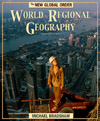 |  World Regional Geography: The New Global Order Update, 2/e Michael Bradshaw,
College of St. Mark and John
South Pacific
Chapter ObjectivesAfter reading and studying this chapter you should be able to:
| 1. Understand the pattern of core and periphery countries and the
distances between them. |
 |  |  | | 2. Identify the five important groups of people that are native to this
region. |
 |  |  | | 3. Describe colonization of Australia, New Zealand, and the South
Pacific Islands. |
 |  |  | | 4. Examine the range of climates and their impacts on human activities. |
 |  |  | | 5. Understand the role of plate tectonics and volcanic activity in
determining the distribution of land. |
 |  |  | | 6. Know the ways that environmental damage is greater than expected in
portions of this region. |
 |  |  | | 7. Differentiate the important characteristics of the states and territories
of Australia. |
 |  |  | | 8. Compare and contrast the economic development of Australia with the
economic development of New Zealand. |
 |  |  | | 9. List New Zealand's old and new exports and markets. |
 |  |  | | 10. Explain the numerous difficulties faced by the islands of the South
Pacific. |
 |  |  | | 11. Document the distinctiveness of Antarctica as compared to other
regions. |
 |  |  | | 12. Know that the populations of these countries are all relatively small,
and in some cases, very small. |
 |  |  | | 13. Discuss the reorientation of attitudes, migration flows, and trade
patterns toward East Asia. |
|



 2002 McGraw-Hill Higher Education
2002 McGraw-Hill Higher Education